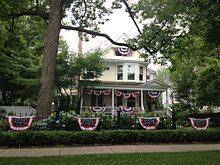Bunting (decoration)


Bunting refers to decorative flags, wide streamers, or draperies made of fabric, or of plastic, paper or cardboard in imitation of fabric. Bunting is also a collection of flags, and the fabric used to make flags. The fabric was originally a specific type of lightweight worsted wool fabric, but can also be cotton.
Description
Bunting are festive or patriotic decorations made of fabric, or of plastic, paper or cardboard in imitation of fabric.[1][2][3][4][5] Typical forms of bunting are strings of colorful triangular flags, lengths of fabric in the colors gathered and draped into swags or pleated into fan shapes, draperies, and wide streamers.[4][5] The colors are often those of national flags.[2][5] Bunting decorations are used on streets and buildings[4] at special occasions[1] and political events.[2]
The term bunting also refers to a collection of flags, and particularly those of a ship;[6] the officer responsible for raising signals using flags is known as bunts, a term still used for a ship's communications officer.[citation needed] Bunting is also the fabric used to make flags.[5][7]
History
Bunting textile was originally a specific type of lightweight worsted wool fabric generically known as tammy,[8] manufactured from the turn of the 17th century,[9] and used for making ribbons[10] and flags,[11] including signal flags for the Royal Navy. It may also be cotton.[5][7] Amongst other properties that made the fabric suitable for ribbons and flags was its high glaze, achieved by a process including hot-pressing.[12]
The origin of the word is uncertain,[13] but bunt means colourful in German.
Gallery
- 4th of July decorations in Roche Harbor include Canadian and U.S. flags and red, white and blue bunting.
- NSE Eridge-Edenbridge celebrations (1988) with Red, White and Blue commemorating the Hundred Years of the Line.
- Example of personalised nursery bunting in the UK
See also
Notes
- ^ a b "BUNTING definition in American English | Collins English Dictionary".
- ^ a b c "BUNTING | definition in the Cambridge English Dictionary".
- ^ "Dictionary.com | Meanings & Definitions of English Words". Dictionary.com.
- ^ a b c "bunting noun - Definition, pictures, pronunciation and usage notes | Oxford Advanced Learner's Dictionary at OxfordLearnersDictionaries.com".
- ^ a b c d e Flags, Parker (March 15, 2014). "What Is Bunting?".
- ^ One or more of the preceding sentences incorporates text from a publication now in the public domain: Chisholm, Hugh, ed. (1911). "Bunting". Encyclopædia Britannica. Vol. 4 (11th ed.). Cambridge University Press. p. 802.
- ^ a b "Bunting - Definition, Meaning & Synonyms | Vocabulary.com".
- ^ "The gradual change of spelling undergone by this name from 'estamet' to 'tammy' had by that date proceeded as far as 'tamett'. By 1633 it had become 'tammet'" (Kerridge 1988, p. 53).
- ^ "Worsted tammies, white and coloured, broad and narrow, were made in Norwich and East Norfolk, seemingly from about 1594, certainly from 1605" (Kerridge 1988, p. 53).
- ^ Scargill 1965, p. 101–110.
- ^ "One special form of tammy, called bunt or bunting, was sold for making flags" (Kerridge 1988, p. 53).
- ^ "They were also highly glazed by hot-pressing and other means." (Kerridge 1988, p. 53).
- ^ Oxford English Dictionary on CD-ROM, Oxford University Press, 2002.
References
- Kerridge, Eric (1988). Textile manufactures in early modern England. Manchester University Press. ISBN 978-0-7190-1767-4.
- Scargill, D.I. (1965). Wakefield: A Study of Arrested Urban Development. Vol. 36. The Town Planning Review. pp. 101–110.
External links
 Media related to Bunting at Wikimedia Commons
Media related to Bunting at Wikimedia Commons



